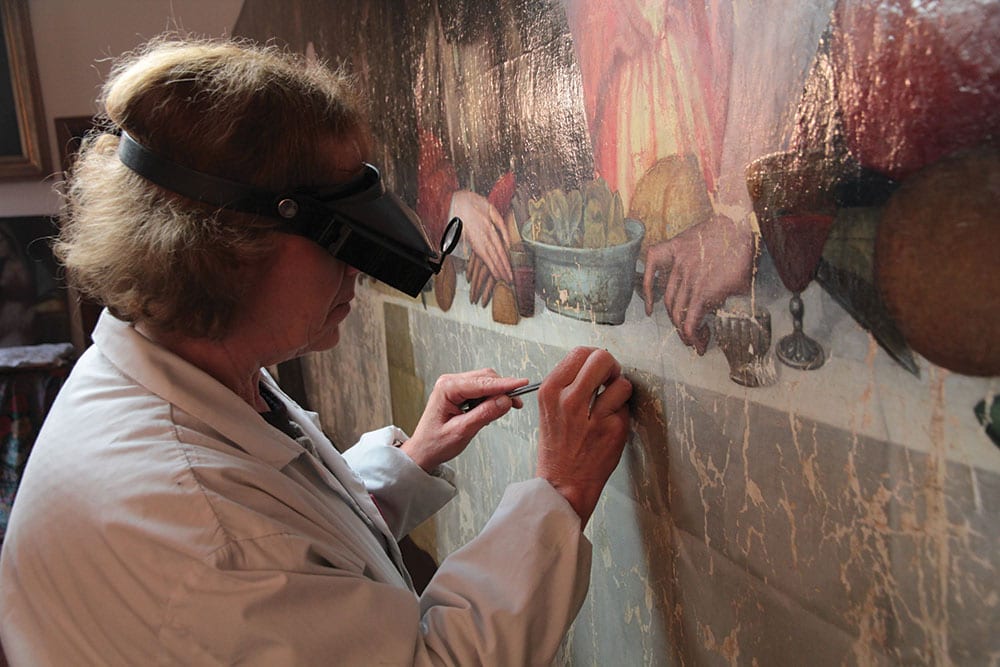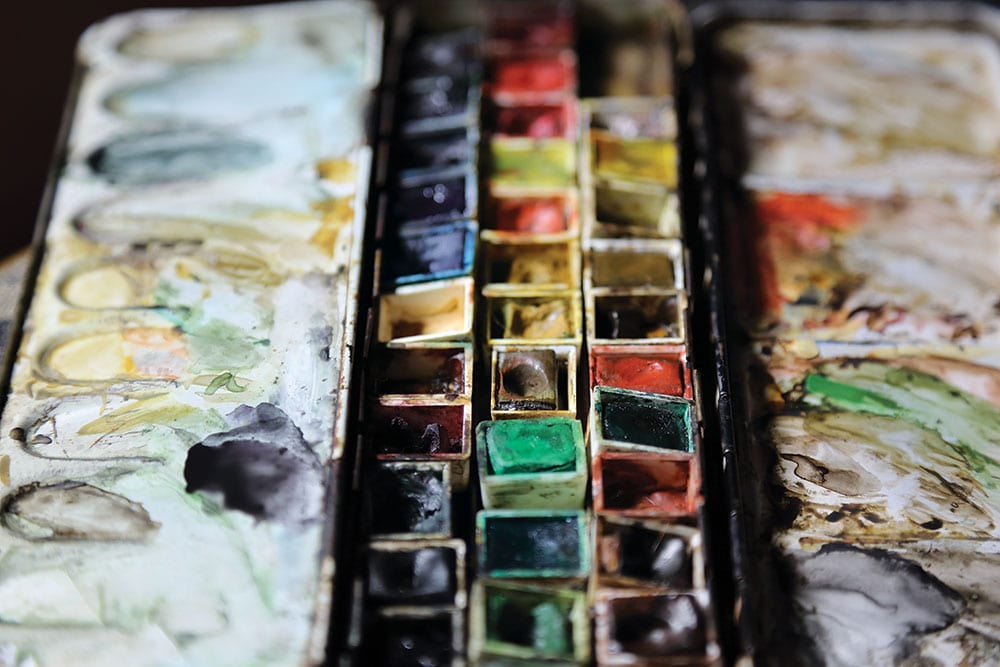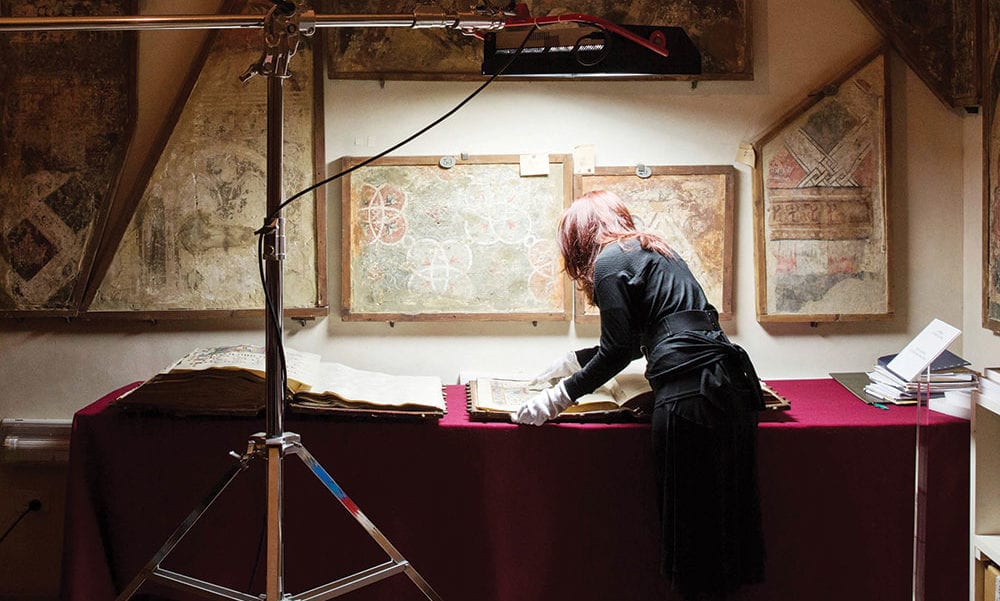by E. Page Leggett
Nearly everyone knows who Michelangelo and da Vinci are. But you’ve probably never heard of Irene Parenti Duclos, Elisabeth Chaplin or Violante Siries Cerroti—female painters who lived and worked in Florence just as the guys famous enough to go by one name did. Advancing Women Artists (AWA), an American nonprofit based in Florence, Italy, is giving them their due. AWA is a global network dedicated to ensuring forgotten women artists are discovered and celebrated. There’s a reason few people know the names of women artists up until, say, Mary Cassatt (1844-1926): Women weren’t allowed to study painting. “There was a time when women had to have a bodyguard with them to go into the Uffizi Galleries,” said Elizabeth Wicks, an independent art conservator who often works with AWA on restoring pieces by Florentine female painters. “It was thought they would be overcome by the male nude statues.” Oh, how far we have come.
But not far enough, believed AWA founder Dr. Jane Fortune, who died in 2018. The author and philanthropist first arrived in Florence in 1962 and was smitten by the ancient and glorious city. An advocate for art preservation and civic engagement, the Indianapolis native became known in her adopted hometown as “Indiana Jane” for her crusading efforts to restore hidden and neglected artistic treasures. She received an honorary doctorate from Indiana University and the Living Legends Award from the Indiana Historical Society. In 2005, Fortune began the work of identifying, restoring and—importantly— exhibiting artwork by female painters that had been languishing in Florence’s museum storage areas. Wicks, who first discovered Florence—and art conservation—as a college student in the 1980s, knew Fortune’s work in art preservation and invited her in 2012 to look at some long forgotten paintings by women that were in a closet of a Florentine museum.

Art conservationist Rossella Lari restoring The Last Supper by Plautilla Nelli. Photography by Francesco Cacchiani.
Fortune proposed to the museum’s leadership that, with Wicks’ help, AWA could restore some of the works. In the end, the museum couldn’t guarantee the restored paintings would be hung. That was a deal-breaker. If AWA is going to invest in researching and restoring a painting or sculpture, the museum must agree to give the work pride of place. It can’t be restored and returned to a closet. That story illustrates one of the difficulties AWA faces in its work. Museums don’t always agree that a long-neglected painting deserves to be on display.
Art & Science
Before you can touch a centuries-old painting, you have to have training—years of it. Wicks did a yearlong painting conservation internship in Washington, D.C., before earning an MFA in painting conservation. There’s both an art and a science to what restorers do. Like a geriatrician examining an octogenarian patient, Wicks has to first diagnose what’s wrong. (And she herself uses a doctor analogy to describe her work. “I love all my patients,” she said.) She has to study, document, and perform chemical tests. There can be an entire painting beneath the painting, and she needs to know if that’s the case. Before she can get out her paints and brushes, she’s got to clean what may be centuries of grime, dirt and possibly previous restorations. Her work is checked at every phase by Florence’s superintendency of art—the official “culture keepers” for the city. The part everyone thinks of as historic restoration—the painting—is just one phase in the process. Does Wicks feel like a plastic surgeon? “Well, sort of,” she said. “But just like you can’t take an 80-year-old woman and make her look 20 again, you can’t take a centuries-old painting and make it look new. You wouldn’t want to. My job is to keep the dignity of an old painting.” And that’s still not the end of the story.

Typical paint palette used by conservationists for a Renaissance painting’s restoration. Photography by Kirsten Hills.
Female Painters: Giving Them Their Identities Back
Restoring artwork is just part of what AWA does, said Linda Falcone, director of AWA Italy. The former journalist has lived and worked in Italy for more than two decades. She and Fortune were close friends, creative colleagues and co-authors. When Fortune died, Falcone became the leader of AWA, a group she describes as “small but doing big things.” “We start with the artist,” she said. While many female painters should’ve been well-known in their day and throughout history, that’s not usually the case. It’s vital work.

AWA conservationist uses delicate finesse and a microscope to restore a painting by Adriana Pincherle. Photograph by Kirsten Hills.
And, Wicks points out: “No other organization is doing what AWA is doing.” “We track down birth certificates,” Falcone said of the detailed detective work she and her team do. “We’re doing more than restoring paintings. We give these women a story. We restore the identities of these women artists. People need to feel a connection to them and their work.” Nothing about the process is easy. “There’s a total absence of first-person documentation for women,” Falcone said. “We have to see what the woman artist’s father, brothers, teachers wrote about her. We’re missing their voices.” AWA has restored 67 works of art since its 2009 founding. (It’s not quick work. One painting can take four years, start to finish, to restore.) One of the most recent examples is also one of the most impressive. Sister Plautilla Nelli’s (1524-1588) The Last Supper is the only known depiction of Christ’s last meal by a female artist in the pre-modern age.
The self-taught artist’s massive canvas—about 21 feet long and 7 feet high—is one of the largest works by a woman artist of the pre-modern era in the entire world. Though women were banned from studying anatomy, Nelli defied conventions of the time by taking on a theme reserved for male artists and creating 13 life-size male figures. Its restoration involved AWA, the municipality of Florence, Florentine civic museums, the superintendent’s office and more. The effort was led by, appropriately, an all-woman team of curators, restoration artists and scientists. Giorgio Vasari, often credited as Italy’s first art historian, wrote about Nelli: “She would have done wonderful things if she had only studied as men do.” Harrumph. That sums up Falcone’s reaction.

Nelli and the other female painters of her time did wonderful things. But women artists’ work can’t be judged alongside their male counterparts. Women were self-taught and couldn’t sketch or paint from life (unless they were painting a still life). Sometimes their fathers had to sign their work; the art fetched more money that way. “Women had a totally different experience from men during the Renaissance and long after,” Falcone said. “We can’t compare their works. We can study them together, but it can’t be a comparative study.” Fortune was a pioneer in trying to give women artists their due. “She asked museum directors, ‘Where are the women?’” Falcone said. “Today, everyone’s asking that. But 15 years ago, it was an original question. “We broke all the rules,” Falcone continued. “We weren’t art historians; we were storytellers. And we just started showing up at museums and asking, ‘Can we go into your cellar?’ The museums didn’t even know what they had in storage. It’s amazing what can happen when you start asking questions.”
Bankrolling Restoration
Enthralled by the restoration effort of Nelli’s Last Supper, donors from all over the world contributed to it. The first phase of fundraising, a crowdfunding campaign called “TheFirstLast,” was launched in 2015 and attracted donors from 19 countries. Besides Italy and the US, donors emerged from Australia, Brazil, Finland, Germany, Ireland, New Zealand, the United Arab Emirates and more. “The Adopt-an-Apostle program,” the second phase of the campaign, matched 12 donors with their respective saint. John was the first to be adopted. Donna Malin, a retired American lawyer and member of AWA’s board of trustees and International Advisory Council, adopted the Christ figure. (“I’m the stepmother of Christ,” she said with a laugh.)

Understandably, no one wanted to adopt Judas, so the “Art Defense Fund” for Judas was established. Ten donors were invited to overlook their distaste and contribute to save the painting’s most reviled—but pivotal—figure. Malin retired in 2017 from Johnson & Johnson after a three-decade career. Mentoring women has always been important to her. She fell for Florence during her first visit nearly 40 years ago and has spent a lot of time in the city ever since. “Florence is a relatively small city, but 40 to 50% of artistic treasures from the Renaissance are there,” she said. A successful fundraiser, she’s led many campaigns for AWA over the years and been a significant benefactor herself. “We are bringing works by women artists out of museum basements,” she said. “And there’s a real joy in that.”

